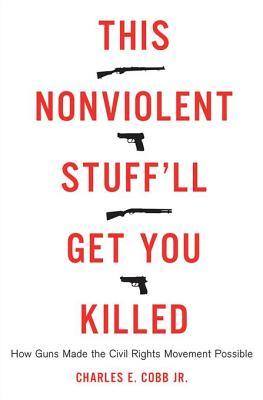
This Nonviolent Stuff'll Get You Killed
How Guns Made the Civil Rights Movement Possible
کتاب های مرتبط
- اطلاعات
- نقد و بررسی
- دیدگاه کاربران
نقد و بررسی

April 14, 2014
In this persuasive long-form essay, Cobb, a journalist who served as a field secretary with the Student Nonviolent Coordinating Committee in the 1960s, describes questions of the propriety of gun ownership and self-defense at the grassroots of the civil rights movement as “an intellectual tea party, perhaps momentarily refreshing but only occasionally nourishing.” Southern blacks remembered instead the lessons of Reconstruction: with the federal government largely absent and indifferent, “Black people would have to fight for their rights locally, and unless they protected themselves from reprisal, no one would.” The movement was deeply imbued with the spirit of nonviolence, but Cobb points out that its organizers and activists were guarded from night riders and state-sponsored terrorism by guns and armed militias, without whom progress in Mississippi and elsewhere would likely have been impossible. Cobb’s bracing and engrossing celebration of black armed resistance ties together two of founding principles of the Republic—individual equality and the right to arm oneself against tyranny—and the hypocrisy and ambiguity evident still in their imbalanced application. “If we exclude the more complex Native American resistance,” Cobb writes, “it can easily be argued that today’s controversial Stand Your Ground right of self-defense first took root in black communities.”

May 15, 2014
A frank look at the complexities and contradictions of the civil rights movement, particularly with regard to the intertwined issues of nonviolence and self-defense.A former field secretary for the Student Nonviolent Coordinating Committee, veteran journalist Cobb (On the Road to Freedom: A Guided Tour of the Civil Rights Trail, 2007, etc.) studies the civil rights revolution at the grass-roots level rather than through the leadership. Martin Luther King Jr. and others in the Southern Christian Leadership Conference officially adopted nonviolent resistance in the form of sit-ins, boycotts and demonstrations, yet these tactics were viewed skeptically by some activists. Violence against black resisters was so prevalent and pernicious, Cobb writes, that retaliatory violence was neither unheard of nor indeed unexpected. The peaceable sit-in at a Woolworth's in Greensboro, North Carolina, on Feb. 1, 1960, for example, contrasted markedly with a subsequent violent clash between black demonstrators and the white mob that set upon them during a sit-in in Jacksonville, Florida. Self-defense with firearms often went hand in hand with nonviolent resistance-indeed, it "ensured the survival...of the freedom struggle itself." Cobb backs up this rather perplexing statement with a variety of historical material, pointing out that blacks in the rural South had relied on guns to protect their families against white supremacist violence since the time of Reconstruction. The author also characterizes slave insurrections as "the taproot of the modern freedom struggle" and explores the contradiction of African-Americans serving in the U.S. military while being deprived of basic civil rights. Yet while retaliatory violence might have been the norm in some communities, it could not bring the vast, radical change that nonviolence did.Thought-provoking and studded with piercing ironies.
COPYRIGHT(2014) Kirkus Reviews, ALL RIGHTS RESERVED.

Starred review from June 15, 2014
Cobb (visiting professor, Africana studies, Brown Univ.) brilliantly situates the civil rights movement in the context of Southern life and gun culture, with a thesis that is unpacked by way of firsthand and personal accounts. The author underscores how the nonviolent political demonstration was always a dangerous enterprise in which Jim Crow laws and marginalization had become a way of life, and on closer examination the reader is shown accounts of the many approaches in which the gun culture of the South and standing up for voting rights and equality went hand in hand. As a departure point from traditional understandings of the time, Cobb follows a number of war veterans' stories from World War I and World War II as being at the vanguard of the intersection of guns and self-defence in Southern civil rights. A comparison text from a slightly different perspective that's worthy of any library is Timothy B. Tyson's Radio Free Dixie. VERDICT For avid U.S. history buffs.--Jim Hahn, Univ. of Illinois Lib., Urbana
Copyright 2014 Library Journal, LLC Used with permission.

Starred review from May 1, 2014
Given the violent resistance to equality for African Americans during the civil rights struggle, many viewed the tactics of nonviolence as either docile or naive or both. Cobb argues that the effectiveness of nonviolence speaks for itself in shining harsh light on the moral outrage of racism and in transforming large swaths of the black population into activists, but he also examines the armed self-defense that undergirded it. Cobb, a former field secretary for the Student Nonviolent Coordinating Committee, reviews the long tradition of self-protection among African Americans, who knew they could not rely on local law enforcement for protection. Martin Luther King Jr. himself, after the fire bombing of his home, kept weapons in his house to protect his family. Cobb offers a collection of memories of freedom fighters and a broad historical perspective, from slave resistance to the Deacons of Defense and Justice, as evidence of the human impulse to self-protection that counterbalanced the tactics of nonviolent resistance. Understanding how the use of guns makes this history of the civil rights movement more compelling to readers, Cobb is, nonetheless, focused on the determination of ordinary citizens, women included, to win their rights, even if that meant packing a pistol in a pocket or purse.(Reprinted with permission of Booklist, copyright 2014, American Library Association.)

























دیدگاه کاربران